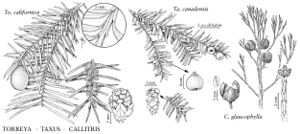Torreya
Ann. Nat. Hist. 1: 130. 1838.
| Taxon | Illustrator ⠉ | |
|---|---|---|
 | Torreya californica Taxus canadensis Callitris glaucophylla | John Myers John Myers John Myers |
Trees dioecious. Bark brown to grayish brown, tinged with orange, fissured. Branches spreading to drooping; twigs nearly opposite. Leaves mostly appearing 2-ranked, rigid; stomates abaxial, in 2 narrow, glaucous, whitish or brownish bands; apex sharp-pointed, spine-tipped, sharp to touch; resin canal central. Pollen cones ovoid or oblong, with 6–8 whorls of 4 sporophylls, each bearing 4 sporangia. Ovules 2, only 1 of each pair maturing. Seed maturing in 2 years; aril green or green with purple streaks, resinous, leathery, thin, completely enclosing woody seed-coat, splitting into 2 parts at maturity; albumen ruminate. x = 11.
Distribution
North America, Asia in China and Japan
Discussion
Two Asian species are planted as ornamentals in North America: Torreya nucifera Siebold & Zuccarini (kaya-nut, Japanese torreya), which yields edible seeds and cooking oil, and T. grandis Fortune (Chinese torreya).
Species 4(–6) (2 in the flora).
Selected References
Lower Taxa
Key
| 1 | Two-year-old branches reddish brown; leaves 3-8 cm, flattened on adaxial side, with 2 deeply impressed, glaucous bands of stomates abaxially, emitting pungent odor when crushed; aril light green streaked with purple; California. | Torreya californica |
| 1 | Two-year-old branches yellowish green, yellowish brown, or gray; leaves 1.5-3.8 cm, rounded on adaxial side, with 2 scarcely impressed, grayish bands of stomates abaxially, emitting fetid odor when crushed; aril dark green streaked with purple; Florida, Georgia. | Torreya taxifolia |